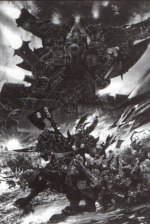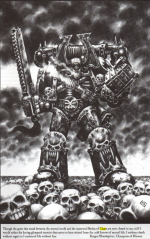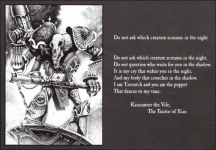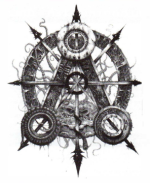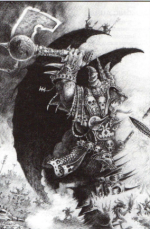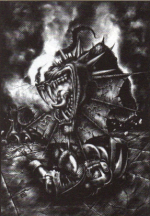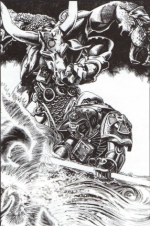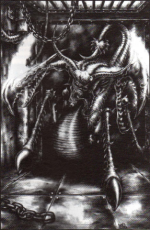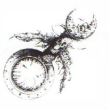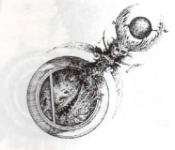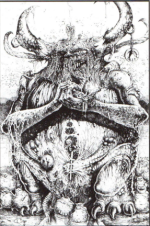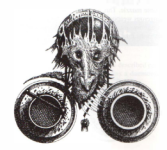SPACE MARINES
The Legions of Adeptus Astartes are more commonly known as the Space Marines — the most powerful and the most dreaded of all human warriors. In some respects they are not really human at all but superhuman — superior in almost every way to an ordinary man. Compared to humanity’s teeming billions there are very few Space Marines indeed. They are far too few to form the sole fighting forces of the Imperium. The Space Marines are the Imperium’s elite fighting troops, a core of highly mobile shock troops trained to fight on land and in space. On the battlefield they are expected to take part in the most dangerous and important attacks, and to hold their positions no matter how hopeless the situation.
Space Marines are entrusted with all sorts of dangerous missions, such as lightning raids behind enemy lines, infiltration attacks to capture vital positions, and tunnel fights in enemy-held cities. They also undertake long voyages of planetary exploration and conquest on behalf of the Imperium, ear-marking planets which are too well defended so that they can be attacked later with the support of the Imperial Guard.
CHAPTERS Space Marines are organised into small independent armies called Chapters. Each Chapter has its own ships, its own uniforms, and its own distinct identity and traditions. Most Chapters operate from a world owned by the Chapter, known as the Chapter Planet. Chapter Planets are part of the Imperium, but they are ruled by the Space Marine Chapter that has its base there. Some Chapters are not based on a planet at all: their base of operations can be a vast space fleet, an orbital asteroid, or a giant space station. All the Space Marines in a Chapter belong to its warrior cult. In many cases the warrior cults of the Space Marines preserve traditions and practices older even than the accepted ritual of the Ecclesiarchy. The details of these practices are rumoured to be barbaric and darkly sinister. Space Marines belonging to a Chapter are therefore spiritual brothers as well as brothers at arms. This dual role as physical and spiritual warriors is very important, and it is what makes the Space Marines such dedicated warriors.
ORIGINS
The Space Marines were created at the very dawn of Imperial history, approximately ten thousand years before the present day. Some of the Chapters can trace their history back to that time. These are the Chapters of the First Founding, created by the scientists of the Emperor to take part in the Great Crusade. Since that time many other Space Marine Chapters have been created, the most recent being those of the Twenty-Sixth Founding. The chart below lists the original twenty Chapters and their original leaders (Primarchs) and uniform colours. Many of these Chapters took part in the rebellion known as the Horus Heresy and were subsequently destroyed or exiled.
THE FIRST FOUNDING
This chart shows the original number designations, names, Primarchs, and unit colours of the first twenty Space Marine Chapters. Those indicated with an asterix rebelled during the Horus Heresy and are no longer part of the Imperial Forces (some have survived as Chaos Renegades in the infernal regions of the Eye of Terror). The names and histories of Chapters 2 and 11 were deleted from Imperial records following the Horus Heresy. The name of Chapter 16, the Lunar Wolves, was changed to Sons of Horus prior to the Horus Heresy, and subsequently to the Black Legion, under which name it now serves the forces of Chaos.
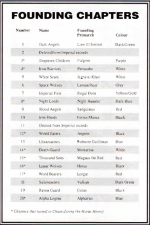
THE DARK ANGELS
Of the Battle Brothers of the Dark Angels history cannot speak. for there are no records of the Dark Chapter’s beginnings, of their part in the Great Crusade, or of their deeds during the terrible wars of the Horus Heresy. Only the legend persists - the legend that once the Dark Angels tectered upon the brink of Chaos, that foul betrayal besmirched the Chapter's valour and made vain all acts of former virtuc. Yet they returned to the fold of the Emperor's love and tore themselves from the very bosom of temptation. Perhaps they sought the Emperor's pardon too late, for ever since they have bora the Mark of the Unforgiven. Can ten thousand years of purgatory absolve those to whom every battle is redemption? Can it be the lost souls of the slain that clamour for the absolution that victory brings?
The Legions of Adeptus Astartes are more commonly known as the Space Marines — the most powerful and the most dreaded of all human warriors. In some respects they are not really human at all but superhuman — superior in almost every way to an ordinary man. Compared to humanity’s teeming billions there are very few Space Marines indeed. They are far too few to form the sole fighting forces of the Imperium. The Space Marines are the Imperium’s elite fighting troops, a core of highly mobile shock troops trained to fight on land and in space. On the battlefield they are expected to take part in the most dangerous and important attacks, and to hold their positions no matter how hopeless the situation.
Space Marines are entrusted with all sorts of dangerous missions, such as lightning raids behind enemy lines, infiltration attacks to capture vital positions, and tunnel fights in enemy-held cities. They also undertake long voyages of planetary exploration and conquest on behalf of the Imperium, ear-marking planets which are too well defended so that they can be attacked later with the support of the Imperial Guard.
CHAPTERS Space Marines are organised into small independent armies called Chapters. Each Chapter has its own ships, its own uniforms, and its own distinct identity and traditions. Most Chapters operate from a world owned by the Chapter, known as the Chapter Planet. Chapter Planets are part of the Imperium, but they are ruled by the Space Marine Chapter that has its base there. Some Chapters are not based on a planet at all: their base of operations can be a vast space fleet, an orbital asteroid, or a giant space station. All the Space Marines in a Chapter belong to its warrior cult. In many cases the warrior cults of the Space Marines preserve traditions and practices older even than the accepted ritual of the Ecclesiarchy. The details of these practices are rumoured to be barbaric and darkly sinister. Space Marines belonging to a Chapter are therefore spiritual brothers as well as brothers at arms. This dual role as physical and spiritual warriors is very important, and it is what makes the Space Marines such dedicated warriors.
ORIGINS
The Space Marines were created at the very dawn of Imperial history, approximately ten thousand years before the present day. Some of the Chapters can trace their history back to that time. These are the Chapters of the First Founding, created by the scientists of the Emperor to take part in the Great Crusade. Since that time many other Space Marine Chapters have been created, the most recent being those of the Twenty-Sixth Founding. The chart below lists the original twenty Chapters and their original leaders (Primarchs) and uniform colours. Many of these Chapters took part in the rebellion known as the Horus Heresy and were subsequently destroyed or exiled.
THE FIRST FOUNDING
This chart shows the original number designations, names, Primarchs, and unit colours of the first twenty Space Marine Chapters. Those indicated with an asterix rebelled during the Horus Heresy and are no longer part of the Imperial Forces (some have survived as Chaos Renegades in the infernal regions of the Eye of Terror). The names and histories of Chapters 2 and 11 were deleted from Imperial records following the Horus Heresy. The name of Chapter 16, the Lunar Wolves, was changed to Sons of Horus prior to the Horus Heresy, and subsequently to the Black Legion, under which name it now serves the forces of Chaos.

THE DARK ANGELS
Of the Battle Brothers of the Dark Angels history cannot speak. for there are no records of the Dark Chapter’s beginnings, of their part in the Great Crusade, or of their deeds during the terrible wars of the Horus Heresy. Only the legend persists - the legend that once the Dark Angels tectered upon the brink of Chaos, that foul betrayal besmirched the Chapter's valour and made vain all acts of former virtuc. Yet they returned to the fold of the Emperor's love and tore themselves from the very bosom of temptation. Perhaps they sought the Emperor's pardon too late, for ever since they have bora the Mark of the Unforgiven. Can ten thousand years of purgatory absolve those to whom every battle is redemption? Can it be the lost souls of the slain that clamour for the absolution that victory brings?



